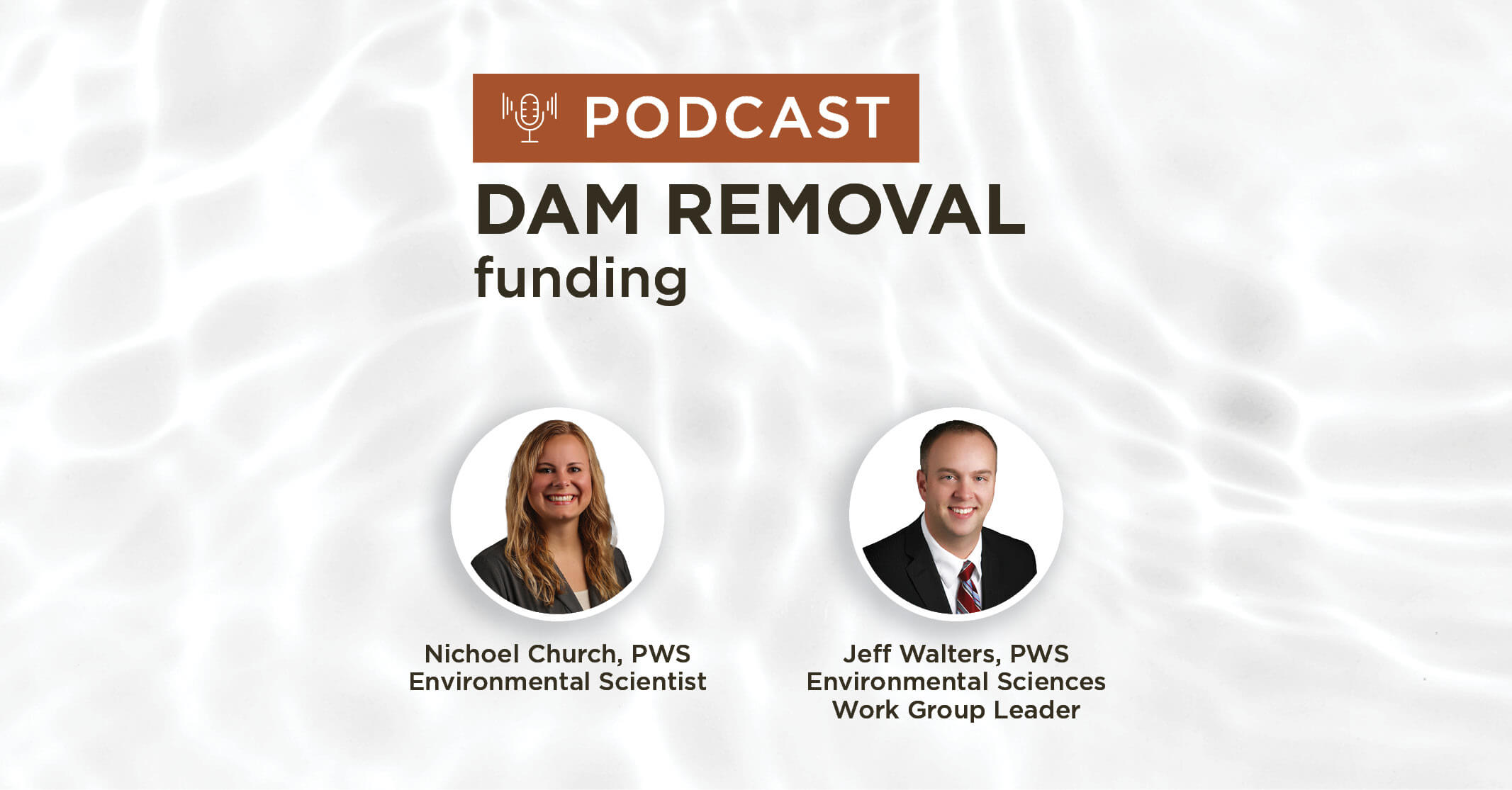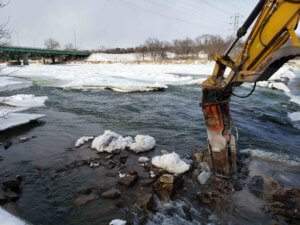Exploring Dam Removal Project Funding
When a dam begins to cause negative environmental impacts or creates safety risks for users of a waterway, removal could be the answer. However, this solution often comes with a hefty price tag. With almost no state or federal funding programs dedicated specifically to dam removal, financing these projects can become a challenge.
In this podcast, environmental experts Jeff Walters, PWS, and Nichoel Church, PWS, explain that with a bit of creative thinking, a combination of several funding sources can be used to successfully fund dam removal projects.
Podcast Agenda
- Acquiring Appropriate Funding (0:18)
- Funding for Dam Removals Private Land Owners (3:35)
- Funding Assistance Requirements for Varying Organizations (5:05)
- Availability of Funding Sources (6:35)
- Timing for Funding Assistance (7:50)
- Cost of Dam Removal vs Dam Modification (9:16)
- Mitigation Banking as a Funding Option (10:49)

Nichoel Church, PWS
Environmental ScientistNichoel Church, PWS
Environmental ScientistMitigation banking development, Wetland delineation, Section 404 permitting, Endangered Species Act (Section 7 Consultation)

Jeff Walters, PWS
Environmental Sciences Work Group LeaderJeff Walters, PWS
Environmental Sciences Work Group LeaderWetland & Stream Delineation & Mitigation, 404 Permitting, Natural Resources Surveys, Lake & Stream Restoration
Acquiring Appropriate Funding
Jeff Walters (0:18)
Let’s talk about funding. There are a lot of funding opportunities. Ultimately, if you are a city, you have bonding capacities, and you have buy-in with the community, but there are lots of different funding assistance that both the public and private can access.
Nichoel Church (0:38)
Not only is it important to know who has control of your dam so you can acquire or apply for the appropriate funding. It also helps with the process of removal, it helps with permitting, it helps the consultant helping you, or if you’re private, it helps you decide who you need to talk to, and which agencies need to be involved. When you’re accessing funding, are you applying for several funding opportunities, and maybe you’re not allowed to use one with another one…
Jeff Walters (1:06)
…or maybe there’s a layering effect where you went after some state funding, and then you decided to go after some fish and wildlife service, or Corp of Engineers funding, and the state process is relatively straightforward, and they have their purview, and they know how they want to use those funds to remove the dam. But that federal agency may add one or more layers of red tape. You may have to go through the NEPA process. You might have to tack on a year or two or three.
Nichoel Church (1:36)
…and additional funding for the project.
Jeff Walters (1:39)
Yeah, much like our FEMA project in Ames where, you know, great money. It was readily available, but it took more time. If you are a community that is willing and has the time to use those funds, to access those funds, and are willing to go through that process, the money is there for you. Whether it’s EPA, Fish and Wildlife Service, or FEMA. The funding buckets vary from year to year, but they can be $25,000 to maybe $100,000 a year. If you happen to be a community that utilizes SRF, you can tap into the Clean Water SRF funding. Granted, you can’t necessarily use Clean Water SRF funds with certain other funding mechanisms like a mitigation bank but you’re entitled to up to 10% of the amount of the loan that you have with SRF. For some communities, especially if they have very large wastewater treatment programs, that can be a very large amount of money.
Nichoel Church (2:34)
A lot of times, the funding assistance might come with additional monitoring. It might require additional documentation on the backend. So you’ve received the funding, you’ve removed your dam, and now you have to monitor your river for 10 years, or now you have to, if it’s Corps of Engineers section 206, it might take 10 years just to remove the dam because they have to go through their process internally. If you want your dam removed quickly, you have to consider funding assistance that will allow you to do that. If you don’t mind, if it takes 10 years, then you’re open to pretty much everything.
Jeff Walters (3:06)
The Iowa Department of Natural Resources and the Corps of Engineers have a database that we access that provides us with ownership, and there are gaps in there from who owns it or who thinks they own their dam, which can be an issue. There are probably hundreds of dams that are very, very small in size that are likely privately owned that don’t show up on this database.
Nichoel Church (3:29)
The information just isn’t there because it’s on private property.
Jeff Walters (3:31)
Right. Someone just built a dam and has a small farm pond.
Funding Dam Removals for Private Land Owners
Nichoel Church (3:35)
Private landowners can still access EPA funding. They can still access Fish and Wildlife Service funding. There are several assistance options available if the dam is privately owned. If it is a farm pond, the Iowa Department of Agricultural Land Stewardship offers funding assistance. The NRCS offers funding assistance. With IDALS, you could contact your soil water conservation district and see if they would offer funding assistance for water quality benefits. There are so many opportunities for funding if it’s a privately owned dam, whether it’s on an intermittent channel or a pond.
Jeff Walters (4:08)
Funding assistance usually comes with a laundry list of water quality monitoring or visual assessments and vegetation assessments, which is all great because likely your goal is some sort of water quality improvement or stabilization. So it’s good to follow up once you’ve completed that project. You want to be aware of any of those catches that might come on the backend of the funding assistance before you dedicate time and resources to go after that funding.
Nichoel Church (4:37)
If the funding is acquired, it doesn’t matter if the EPA completes their survey or Fish and Wildlife completes their survey or if the landowner completes the survey. It should be listed with the funding assistance, who is going to be completing the documentation, and how often, if it’s annual, or bi-annual. If the private landowner can complete it. If EPA wants to complete their own or hire a consultant. That would all be laid out so you would know what is expected with acquiring that funding.
Funding Assistance Requirements for Varying Organizations
Jeff Walters (5:05)
So, while the Corps of Engineers, SRF, and Fish and Wildlife Service, understand that safety is important, that’s not their purview. They’re interested in saving lives, but their goal is the improvement to the environment. We want to help craft that information so that when we can
submit applications on the city’s or municipality’s behalf or private landowner for that matter, the answers and the information we provide to a specific regulatory agency is geared to what they are looking for.
Nichoel Church (5:39)
That’s true. It really helps to understand the agency’s perspective. Why are they offering this funding assistance? What do they get from it? The state and the federal government just doesn’t have funding to give out for saving lives. If that was the number one reason that funding was available for everyone would apply for it. Because we know that that’s a benefit of removing a dam. But the EPA, they want to collect the data. They want to have an understanding of the benefit of removing the dam from an environmental water quality perspective. Corps of Engineers would require stabilization monitoring. Fish and Wildlife Service has habitat surveys and fishing surveys completed by the DNR. They might require a consultant to do that survey. It really just depends on the funding assistance, and we would help you describe to whoever we’re asking money from, why we are requesting it, and how this would benefit them. That’s very important.
Availability of Funding Sources
Jeff Walters (6:35)
The money is very competitive, and it’s competitive not only because a lot of people are applying for it, but those funding pots vary from year to year. At the state level with the Iowa Department of Natural Resources, they’re allocated different amounts of money each year for low head modification and removals. They also have a couple of other programs, but there is an application process, an approval process, and a selection process. It can be very, very competitive.
Nichoel Church (7:03)
Not only is it competitive, but funding is always limited. Annually, when the fiscal year budgets come out, we are on top of those grant or funding assistance opportunities for our projects. But we have to know that the projects are there. We don’t keep tabs on funding assistance if we don’t have a project. We’re very interested in talking to the agencies. We have several employees go out to Washington D.C. every year and lobby for additional funding. It’s very important for us and our clients to get the maximum amount of benefit and assistance that they can. We are willing to go above and beyond for our clients. It’s just that we have to know that that project is there.
Jeff Walters (7:39)
It’s great to get in early so that we can understand why you want to remove or modify a dam. Those whys really play a role in funding assistance.
Timing for Funding Assistance
Jeff Walters (7:50)
In terms of timing for applications, they vary throughout the year. There’s a January one, a March one, September one deadlines for a lot of this funding. If you are an SRF user, you’ve probably gone through that process. You probably have stars on your calendar, knowing exactly when those applications are due.
Nichoel Church (8:10)
There’s also a process that we have to consider for design. If we’re aware of a project today, we wouldn’t necessarily go after funding tomorrow because we wouldn’t know what our design process would be. That takes time. If we were aware of a project today and we figured out what the client wanted and what they were interested for removal, then we would be aware of our options and our ranges because we wouldn’t want to fill out an application for funding that we couldn’t use. So we would definitely want to work through the design process a little bit and then apply for the funding and fiscal years are annual, which is great. So even if we miss the deadline on one, there’s always another opportunity for something else or to reapply a year from that date.
Jeff Walters (8:52)
Right and we did that with Clean Water SRF projects where we were looking for certain benefits and SRF said let’s apply again and we can reorganize the money for you for dam removal projects, but let’s make sure we have a good emphasis on water quality.
Nichoel Church (9:11)
Exactly. Because that is a requirement of the State Revolving Fund use of that money.
Cost of Dam Removal vs Dam Modification
Jeff Walters (9:16)
Funding’s very important because, without the dollars, you’re not removing that dam.
Nichoel Church (9:21)
Full removal is always the most expensive option because you are completely removing all of that concrete. You are completely removing and stabilizing the channel bed, the stream bed, you have to consider the channel profile. If you’re not at bedrock, you don’t want a significant scour pool downstream. You also don’t want head cutting upstream. There are several factors that you have to consider with a full removal. There are also several factors you have to consider with a modification. For larger dams, it will always be more expensive to completely remove a dam, but sometimes modifications are just not an option.
Jeff Walters (9:59)
Right. We go through a benefit-cost analysis when we look at the dam itself and the up and downstream benefits and repercussions of that removal. So, briefly, we touched on Squaw (Ioway) Creek here a couple of times. That was FEMA Hazard Mitigation Grant Program, and that program paid for 85% of the dam removal and the in-stream structure, bank stabilization, design, and environmental documentation for that project.
Nichoel Church (10:27)
Right, and that’s just it. With the funding assistance that FEMA and the DNR provide for failure structures, it’s important to also know the condition of your dam. If it’s a low head dam that you just want to remove, that’s one thing. If it’s imminent to fall into the river, that’s a different story. The condition of the dam would also be important to know as we would proceed with funding applications and assistance.
Mitigation Banking as a Funding Option
Jeff Walters (10:49)
One funding mechanism that we didn’t list out but is gaining a lot of popularity in the Midwest is mitigation banking specifically for streams. We were very fortunate to be the first in the state to have a stream mitigation bank that was based on dam removal in Fort Dodge. It was a very unique process, not only because it was the first in the state, but we were removing two dams with one project, and we had a full removal of the little dam. Then we had initially a full removal of the Hydro Dam, but circumstances with some regulatory agencies, specifically SHPO (State Historic Preservation Office), required us to keep some of the dam for historical purposes. The benefit of removing a dam above and beyond water quality, safety, and recreational benefits was the city of Fort Dodge is going to reap the benefits of being a mitigation bank so they can sell stream credits, which help to pay off the bond for this project and that money will go to future recreational endeavors within the Des Moines River.
Nichoel Church (11:55)
As part of that process of funding assistance review for that particular project, we started off not with mitigation banking. Before we even got involved, the city went to the Corps of Engineers and asked for their help with section 206. So the Corps of Engineers would essentially remove the dam on behalf of the city of Fort Dodge. It wasn’t free. It was going to cost 50/50 and the Corps of Engineers would’ve had to go through their own internal sections, their own branches internally for review, which would have tacked on quite a bit of money. The city of Fort Dodge decided to look at SRF funding from the DNR, which would have worked out. It would have paid for most of the dam removal.
Jeff Walters (12:37)
Yeah, the Clean Water SRF funding would have paid for a substantial amount of the project, but we came up with the idea of removing the dams as part of a mitigation banking process. We worked with the Corps of Engineers, the EPA, and the DNR. They agreed this would be a great candidate project, but one of the conditions was with a mitigation bank, you can’t use federal funds for mitigation bank. So, the city had to decide, and they went with the mitigation banking option. That process added about a year. But it also gives the city great financial flexibility in how they can use future dollars. Mitigation banking is a great opportunity if those other funding mechanisms don’t work.

